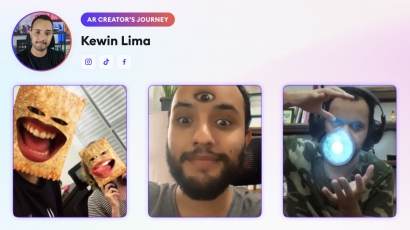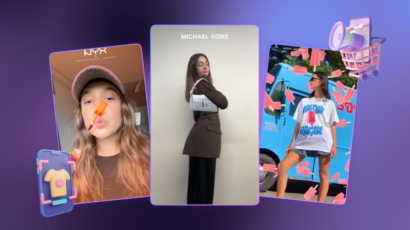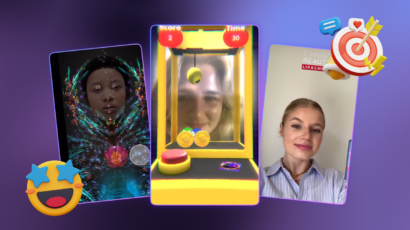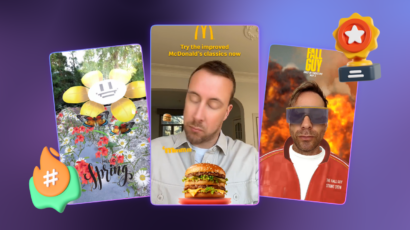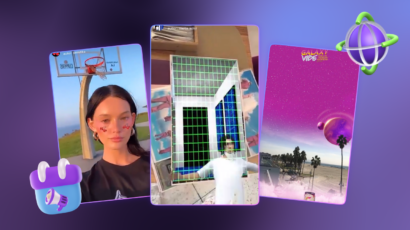Today’s AR Journey is about Kewin Lima, a self-taught graphic designer who ventured into augmented reality (AR) through the Meta Spark platform. He started sharing his knowledge on YouTube and turned his passion into a career. AR is both an emotional and technical experience for him, representing a convergence of beloved media. He predicts a growing demand for AR in daily life, leading to more job opportunities. Dive into the full interview to learn more about Kewin’s amazing experiences and thoughts about AR.
Let’s start from the beginning! How did you start your AR journey? What inspired you to become a creator and what keeps you motivated to continue creating for this industry?
Before starting my journey I worked as a graphic designer in a small advertising agency, I was always self-taught and never had any academic or technical training and because of that I always found it easy to learn new things and I did it since I was a child until I met Spark and I found out that it was free and didn’t need a code, I dived in and at that time I didn’t have much content in my language (Portuguese from Brazil) so I decided to share my knowledge on YouTube, without monetary pretensions or anything, I just wanted to know more people and accelerate my learning process, this took on a much greater proportion than I expected and from then on I managed to make a living from this educational part and also from freelances, today I am passionate about teaching and learning and doing new things and executing challenges is what moves me, I have a great desire to help build a more solid market in my country, that’s why I insist on creating content in the area, I believe that people in general still don’t understand very well what we do and that when they understand they will see as beautifully as we see and I will do what I can to contribute to that.
What is AR for you?
I manage to answer in two ways, the first one in an emotional way, AR today is a big part of my life, today almost all my social circle is made up of creators and the many doors that this opened for me cannot not be considered as my great love ahahaha, now in a technical way, AR for me is in a very practical way the junction of several media that I love, music, cinema, games, all of that together, in a new way, AR is the future.
How do you see the future of AR evolving? What kind of opportunities do you think it will bring to creators and brands?
I think the demand for AR will increase more and more from the moment that technology enters people’s daily lives, not only as beauty or entertainment tools, but really in everyday life, when cooking, driving, to communicate and the more this happens, the more space opens up in the market for professionals in the area, I can see in the not so distant future, fixed vacancies for professionals in the area in the most diverse companies in the most diverse segments, so I would say to no one to give up that good things are coming for years to come
Who or what inspires you in your work, and can you describe your working process? Do you follow a plan or work spontaneously? Do you have a specific style that sets you apart from other creators?
There are several scenarios, in the scenario where I have my authorial creations without a briefing I am always looking for challenges and I use things that I already like as inspiration because I have more motivation to go to the end and the final result most of the time pleases me, so I look for a lot of inspiration in cinema, games and anime… now when it comes to work, I have a background in advertising so my creative process for marketing is already well developed, usually together with my clients I participate from the idea to the execution, I often receive ideas ready but I always add something from my experience, and I think that my big differential in the market is being very versatile and being able to manage in several different scenarios.
Can you share an example of a project where you pushed the boundaries of what is possible with AR technology and what kind of impact did it have?
The briefing brought a challenge to show consumers that an aesthetic product, a makeup was waterproof, this project was done during the pandemic and we managed to bring with AR the experience of having the product realistically underwater, it was a success at the time and I am very proud of it.
Can you list the brands you have worked with? (list links of experiences if possible) What are the project(s) you’re most proud of?
I have already worked with giant brands such as NBA, Meta, Warner, Netflix among others, but the one that I am most proud of was a job done for Jhonsons & Jhonsons where, together with the agency, we brought during the pandemic an experience of breast cancer self-examination within an effect from instagram, had a great social impact at the time, in addition to collecting several awards around the world.
Collaboration is a crucial aspect of creating successful AR projects. Can you share an example of a project where you had to balance a client’s needs with your creative vision? How did you navigate that challenge?
I can’t mention just one because all the projects I do I want to give the client’s vision together with ainja, I think this is crucial, even because the client himself knows more about the work itself and the project’s objectives than I do, so we always combine my creative side with the client’s expertise.
How do you stay up-to-date with the latest trends and technology in the AR industry, and how do you incorporate this knowledge into your work?
I’ve always been a technology enthusiast and I’ve always followed many influencers in the area, so naturally I already receive a lot of things just through the algorithm, besides giving me challenges I always end up discovering new things and that’s what keeps me always evolving
Can you share any tips or tricks you’ve learned along the way that have helped you to create successful AR projects?
I believe that my tip would be to study UX, many creators do not come from a development and programming background, like me, and they overlook several user experience issues and that makes all the difference, what I always say is, what’s the use can you create an amazing effect if no one can use it?
What do you enjoy most about being an AR creator, and how do you balance the technical aspects of AR creation with the creative side? What advice would you give to aspiring AR creators who are just starting out?
What I really like is that as it’s a new area, there are many things that nobody has ever done and you can be the first to bring something new to the world and mine for those who are starting, it’s really starting slowly because you can end up getting frustrated in the process, sometimes we have ideas that we haven’t been able to execute yet, in those cases I keep them for the future.
Big thanks to the awesome Kewin Lima for sharing his personal story and amazing career as an AR creator with us. We’re so excited to witness more of his incredible achievements in the coming days!
